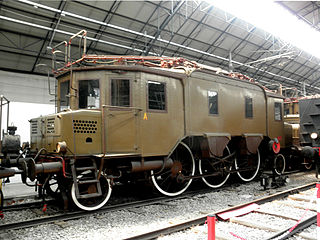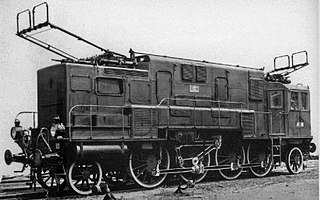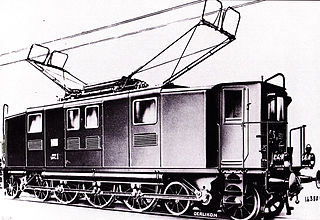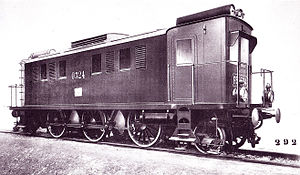
The British Railways Class D3/7 were a class of 0-6-0 diesel electric shunting locomotives built as LMS Nos. 7080–7119. The class were built from May 1939 through to July 1942 by the London, Midland and Scottish Railway at their Derby Works using a diesel electric transmission supplied by English Electric.

The FS E.645 and E.646 are two classes of similar electric locomotives used on Italian railways. They were introduced during the 1950s and they were retired in 2009.

The E.464 is a class of Italian railways electric locomotives. They were introduced in the course of the 1990s for hauling light trains, especially for commuter service. They were acquired by FS Trenitalia to replace the old E.424 and E.646, dating from the 1940s and 1950s. The class was originally designed by ABB Trazione, later ADTranz, and produced in the Italian plant of Vado Ligure.
Giuseppe Bianchi was an Italian railway engineer on the Ferrovie dello Stato between 1913 and 1946.

The FS Class D.443 is a class of diesel-electric locomotive used in Italy, introduced in the late 1960s and still in service.

The FS Class E.330 was a small class of three-phase electric locomotive used in Italy, introduced in the 1910s.

The FS Class E.405 is a class of electric locomotive built in 42 units by ADTranz originally for the Polish State Railways (PKP), but later acquired by Trenitalia Italian state railways.

The Ferrovie dello Stato Class 625 is a class of 2-6-0 'mogul' steam locomotives in Italy. The class is commonly known by the nickname Signorine, or Signorina in the singular, because of their perceived grace and beauty compared to other locomotives.

The Ferrovie dello Stato Class 740 is a class of 2-8-0 'Consolidation' steam locomotives.

The Ferrovie dello Stato Class 640 (Italian: Gruppo 640 is a class of 2-6-0 'Mogul' steam locomotives in Italy. Commonly nicknamed "Signorine", a nickname shared with the similar Class 625, these locomotives were the first superheated steam locomotives in Italy.

The Ferrovie dello Stato Italiane Class 940 is a 2-8-2 steam tank locomotive, derived from the Class 740 tender locomotive.

The Ferrovie dello Stato Italiane Class 835 is a 0-6-0 steam locomotive; it was the standard steam shunter of the FS.

The FS Class E.360 were electric locomotives of the Italian State Railways (FS), using three-phase alternating current, built for the operation of the Valtellina line. They were ordered by Rete Adriatica and were originally numbered RA 361–363. Italian railways were nationalized in 1905 and they then became FS E.361-363 They were leased to Swiss Federal Railways (SBB) in 1906 and returned to Italy in 1907.
The FS Class E.470 was an electric locomotive class of the state-owned Italian railway Ferrovie dello Stato. It was used on the Italian three-phase test line from Rome-Sulmona especially in express train service. After the end of the trial operation in 1945, the locomotives were scrapped, and no locomotive of the class has been preserved.

The FS Class E.471 locomotives were prototype three-phase AC electric locomotives designed for the Italian State Railways (FS). They constituted the first Italian experiment in using a phase converter. The final goal was to power them with single-phase alternating current, constituting the first case of a European locomotive of this type designed according to modern criteria. However, the difficulty of the development, and political interference, led to the abandonment of the project.

The Ferrovia della Valtellina is a railway line in Italy that runs from Lecco to Valtellina and Valchiavenna. It was opened in 1894 and electrified on the three-phase system in 1902. It is now electrified at 3 kV direct current and operated by Trenord.

The FS Class E.430 locomotives, initially classed as RA 34, were three-phase alternating current electric locomotives of the Italian railways. They were built for Ferrovia della Valtellina by Ganz and MÁVAG in 1901 and had a power output of 440 kW and a haulage capacity of 300 tons. One locomotive is preserved.

FS Class E.332 was a class of three-phase electric locomotives of the Italian State Railways (FS). They were used for the haulage of passenger trains between 1917 and 1963. Designed and built at the same time as the FS Class E.331, they represented an attempt by FS to extend the use of three-phase AC electric traction from primary to secondary routes. Their performance was disappointing and they were relegated to a marginal role, in which they remained despite several modifications.

FS Class E.321 was a class of 17 third-rail electric locomotives, built for the Italian State Railways (FS) for operation on the Varese line and on the underground line in Naples.
FS Class E.620 was a class of third-rail electric locomotives built by Officine Reggiane for the Italian State Railways (FS). They were built in 1925 using motors and electrical equipment from Class E.10 railcars which had been withdrawn in 1923. They were equipped with six nose-suspended direct current traction motors with a total output of 950 kW. The drive to the axles was by gears and the maximum speed was 85 km/h. After World War II they were converted to 3,000 volt DC operation and became FS Class E.621.
This page is based on this
Wikipedia article Text is available under the
CC BY-SA 4.0 license; additional terms may apply.
Images, videos and audio are available under their respective licenses.

















